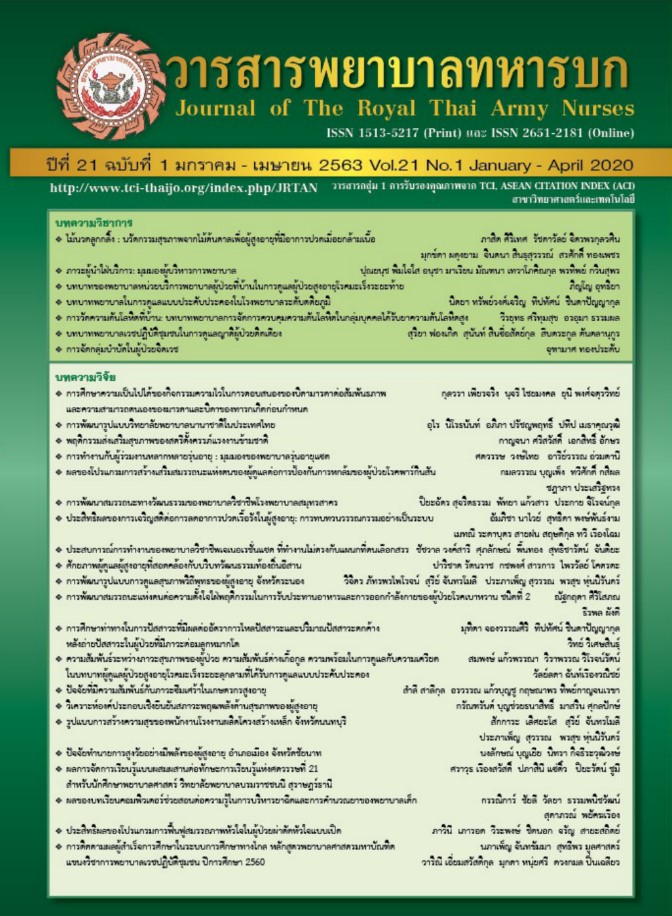The Factors Predicting Post-Hospital Discharge Chest Pain Status Among Acute Coronary Syndrome Patients During The First Year
Keywords:
Factors predicting chest pain status, chest pain status, Acute coronary syndromeAbstract
This predictive correlation research was to determine the factors for predicting post-hospital discharge chest pain status among acute coronary syndrome patients during first year. The samples were the acute coronary syndrome patients who following at outpatient department of medicine of Thammasat University Hospital. Data were collected from September, 2018 to January, 2019. The sample consisted of 181 participants, all of whom completed five sections of a self-administered questionnaire comprising the following: 1) Sociodemographic and Health Status Questionnaires 2) Post-ACS Stress Questionnaires 3) Sleep Quality Questionnaires 4) Post -ACS Self-management Behaviors Questionnaires and 5) The Seattle Angina Questionnaire. Data were analysed using descriptive statistic, Chi-square test, Spearman’s rank correlation coefficient, Pearson’s product correlation coefficient, and Stepwise multiple regression analysis.
The results found that the mean scores of participant’s chest pain status were moderate level. By examining the stepwise multiple regression for predicting chest pain status, it was found that the factors that could predict this status included age, body mass index, occupation, ACS diagnosis, self-management behaviours, sleep quality, and smoking. All seven variables were able to predict chest pain status at 43.1 percent.
Based on the findings, the results from this study provide useful information for developing programmes to prevent chest pain in this group in the future.
Downloads
References
2. Bohplian, S., & Untaja, P. Nurses’ Roles in Decreasing Delay Access to Treatment in Acute Coronary Syndrome Patients. Journal of The Royal Thai Army Nurses. 2015;16(2): 114-122. (In Thai)
3. Strategic and Planning Devision Office of the Permanent Secretary, Ministry of Public Health. Public health statistic 2017. Nontaburi: Minitry of Public Health; 2017. (In Thai)
4. Libby, P., & Braunwald, E. (2005). Braunwald’s Heart Disease A Textbook of Cardiovascular Medicine. Philadelphia: Elsevier Saunders.
5. Michael, J. D. The pathophysiology of acute coronary syndromes. Heart & Lung. 2017;83:361
6. Schiza, S. E., Simantirakis, E., & Siafakas, N. M. (2010). Sleep patterns in patients with acute coronary syndromes. Sleep Medicine, 11(2), 149-153.
7. Tsutsui, T., Tanaka, H., Nishida, A., & Asukai, N.Posttraumatic stress symptoms as predictive of prognosis after acute coronary syndrome. General Hospital Psychiatry. 2017; 45: 56-61.
8. Tanmanee, Y. Relationship between cardiac pain intensity, Anxiety, Perceived control of sleep, and Quality of sleep among acute coronary syndrome patients. Thesis of Adult Nursing. Chonburi: Burapha university; 2016. (In Thai)
9. Lorig, K. R., & Holman, H. Self-management education: history, definition, outcomes, and mechanisms. Annal of Behavior Medicine. 2003; 26(1): 1-7.
10. Thorndike, R. M. (1978). Correlation Procedures for Research. New York: Gardner Press.
11. Foa, E., Cashman, L., Jaycox, L., & Perry, K. The validation of a self-report measures of PTSD: the PTSD diagnostic scale (PDS). Journal of Psychiatic Nursing. 1997; 445-51.
12. Buysse, D. J., Reynolds, C. F., & Kupfer, D. J. The Pittsburgh Sleep Quality Index: a new instrument for psychiatric practice and research. Psychiatry Research. 1989; 28(2): 193-213.
13. Chaiwong, N. Factors influencing Self-management Behaviors among Acute Myocardial Infarction Patients, Thai Pharmaceutical and Health Science Journal, 2014; 9(3): 112-119. (in Thai)
14. Sanchis, J., Bodi, V., Nunez, J., & Bosch, M. J. New Risk Score for Patients With Acute Chest Pain, Non-ST-Segment Deviation, and Normal Troponin Concentrations: A Comparison With the TIMI Risk Score. Journal of the American College of Cardiology. 2005; 46(3): 443-9.
15. Spertus, J. A., Winder, J. A., Prodzinski, J., & McDonell, M. Development and evaluation of the Seattle Angina Questionnaire: a new functional status measure for coronary artery disease. Journal of American College of Cardiology 1995; 25(2): 333-41.
16. Alcantara, C. The association of short sleep after acute coronary syndrome with recurrent cardiac events and mortality. International Journal of Cardiology. 2014; 171(2): 11-2.
17. Malik, M. A., & Taseer, I.-U.-H. (2013). Chest Pain as a presenting complaint in patients with acute myocardial infarction (AMI). Pakistan Journal of Medical Sciences, 29(2), 565-568.
18. Roohafza, H., Talaei, M., Pourmoghaddas, Z., Rajabi, F., & Sadeghi, M. (2012). Association of social support and coping strategies with acute coronary syndrome: a case-control study. Journal of Cardiology, 59(2), 154-159.
19. Sofi, F., Fabbri, A., Marcucci, R., & Gensini, G. F. (2011). Lifestyle modifications after acute coronary syndromes in a subset of the AMI-Florence 2 Registry. Acta Cardiol, 66(6), 791-796.
20. Wachira, J., & Cannon, C. (2013). Cardiovascular disease and bridging the diagnostic gap. SD Medicien, 366-369.
21. Virmani, R., Burke, A. P., Farb, A., & Kolodgie, F. D. (2006). Pathology of the Vulnerable Plaque. Journal of the American College of Cardiology, 47(8), 13.
22. Bohplian, S. Low Cardiac Output Syndrome in Cardiac Surgery Patient: Challenging Cardiovascular Nurses. Journal of The Royal Thai Army Nurses. 2014;15(2):135-140. (In Thai)
Downloads
Published
How to Cite
Issue
Section
License
บทความหรือข้อคิดเห็นใดใดที่ปรากฏในวารสารพยาบาลทหารบกเป็นวรรณกรรมของผู้เขียน ซึ่งบรรณาธิการหรือสมาคมพยาบาลทหารบก ไม่จำเป็นต้องเห็นด้วย
บทความที่ได้รับการตีพิมพ์เป็นลิขสิทธิ์ของวารสารพยาบาลทหารบก
The ideas and opinions expressed in the Journal of The Royal Thai Army Nurses are those of the authors and not necessarily those
of the editor or Royal Thai Army Nurses Association.






